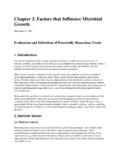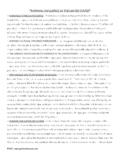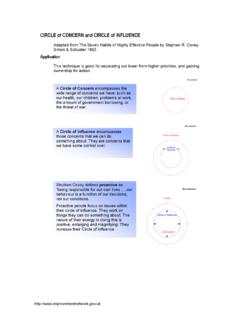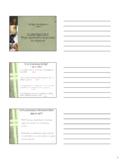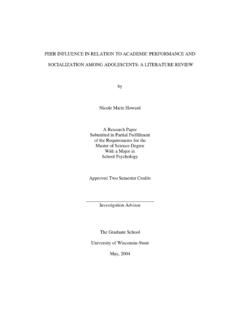Transcription of Influence of Climate, Soil, and Cultivar on Terroir
1 Influence of climate , Soil, and Cultivar on Terroir 207Am. J. Enol. Vitic. 55:3 (2004)207 Terroir has been acknowledged as an important factor inwine quality and style, particularly in European vineyards(Falcetti 1994). It can be defined as an interactive ecosys-tem, in a given place, including climate , soil, and the vine(rootstock and Cultivar ) (Seguin 1988). Some authors alsoinclude human factors such as viticultural and enologicaltechniques in their definition of terrior (Seguin 1986). It isdifficult to study the effect of all the parameters of Terroir ina single experiment. Many authors have assessed the im-pact of a single parameter of Terroir on grape quality: cli-mate (Winkler et al. 1974, Huglin 1978, Gladstones 1992), soil(Seguin 1975, van Leeuwen and Seguin 1994), Cultivar (Riou1994, Huglin and Schneider 1998), or rootstock (May 1997).
2 The effects of vine water and nitrogen status, linked to soiltype, have been shown for Cabernet Sauvignon (Chon etal. 2001) and Merlot (Tregoat et al. 2002). Two studies haveinvestigated the combined effects of two Terroir parameters:soil and climate (Duteau et al. 1981) and soil and Cultivar (van Leeuwen 1995). Rankine et al. (1971) attempted tostudy the effects of soil, climate , and Cultivar ; however, thesoils were situated in different climatic zones, making it dif-ficult to separate the effect of soil and the effect of this study, the influences of climate , soil, and cultivarwere examined simultaneously. Three red cultivars grownon three soil types located in a homogeneous climatic zoneInfluence of climate , Soil, and Cultivar on TerroirCornelis van Leeuwen,1,2* Philippe Friant,1 Xavier Chon ,1,2 Olivier Tregoat,1,2 Stephanos Koundouras,2 and Denis Dubourdieu21 ENITA de Bordeaux, 1, Cours du G n ral de Gaulle, BP 201, 33175 Gradignan-Cedex, France;2 Faculte d nologie de Bordeaux, 351 Cours de la Lib ration, 33405 Talence-Cedex, France.
3 *Corresponding author [Email: We would like to thank many students from the Facult d nologie de Bordeauxand from the ENITA Bordeaux who participated in this research, especially Jer me Heranval,Philippe Guigal, Olivier Leriche, Romain Renard, Emily Walling, Anna Smolinski, Pierre-Luc Alla,Matthieu Bordes, and Marie-Eve Jaeck. Thanks to Lee Valente for language correction and to OlivierLavialle for help with statistical submitted October 2002; revised May, November 2003 Copyright 2004 by the American Society for Enology and Viticulture. All rights : The three main components of Terroir soil, climate , and Cultivar were studied simultaneously. Vinedevelopment and berry composition of nonirrigated Vitis vinifera L. cv. Merlot, Cabernet franc, and Cabernet Sauvignonwere compared on a gravelly soil, a soil with a heavy clay subsoil, and a sandy soil with a water table within thereach of the roots.]
4 The Influence of climate was assessed with year-to-year variations of maximum and minimumtemperatures, degree days (base of 10 C), sunshine hours, ETo, rainfall, and water balance for the period 1996 to2000. The effects of climate , soil, and Cultivar were found to be highly significant with regard to vine behaviorand berry composition (an example being anthocyanin concentration). The impacts of climate and soil were greaterthan that of Cultivar . Many of the variables correlated with the intensity of vine water stress. It is likely that theeffects of climate and soil on fruit quality are mediated through their Influence on vine water words: Terroir , soil, climate , Cultivar , vine, water deficitwere used. The Influence of climate was studied through theyear effect. Our objectives were to assess the Influence ofthe three parameters on vine development and grape com-position and to establish a scientific basis for a better un-derstanding of how Terroir influences vine and MethodsThis study was carried out from 1996 through 2000 inthree Saint-Emilion vineyards located in the Bordeaux re-gion.
5 The sites were located at the following coordinates:plot G, lat. 44 56'21", long. 0 11'21"; plot S, lat. 44 56'13",long. 0 10'59"; plot A, lat. 44 56'06", long. 0 10'51". TheVitis vinifera L. cultivars were Merlot (clone 181), CabernetSauvignon (clone 191), and Cabernet franc (clone 326). Allthree cultivars were grafted onto 3309C soils were studied. The first was a gravelly Soil, Arenic Eutrudept, containing over 50% stones in every iden-tified layer explored by the root system. The fine earth wasmainly composed of sand (Figure 1A). Rooting depth waslimited to m by an impermeable layer. Soil water-holdingcapacity was 40 mm (calculated according to Leclech 2000).The second soil had very heavy clay subsoil between m in depth (Albaquic Hapludalf). The amount ofclay in this layer was greater than 60% (Figure 1B).
6 Soilwater-holding capacity was 168 third was a sandy soil with a sandy-clay texture be-low m in depth (Sandy Typic Psammaquent) (Figure 1C).The water table was close to the surface, varying from at the end of the winter to m at the end of the of a soil pit showed that rooting depth m. Thus, it can be considered that roots remained incontact with the capillary zone above the water tablethroughout the growing season. No water-holding capacitywas calculated for this soil because vine water uptake fromthe water table was van Leeuwen et J. Enol. Vitic. 55:3 (2004)Climatic parameters vary both spatially (regional climaticvariations) and in time (year effect). Since the plots were lo-cated less than one km apart, climate was considered to behomogeneous among the plots in a given vintage. There-fore, the effect of climate was studied in terms of year-to-year variations in temperature, rainfall, ETo, sunshine hours,and water balance (vintage effect).
7 Climatic data were mea-sured on site with an automatic weather station (BV14/15/15; CIMEL, Paris, France). Mean high and low temperatures,degree-day base of 10 C, average daily sunshine hours,average daily ETo (reference evaporation, calculated accord-ing to Penman 1948), rainfall, and water balance among phe-nological stages were calculated for each combination soilx Cultivar and then averaged. Water balance was modeledas rainfall k*ETo (mm). Given the characteristics of thetrellis system, crop coefficient was estimated as k = fromflowering to harvest and k = from budbreak to flowering(Riou et al. 1994).On each of the three soil types, a homogeneous plot ofmature vines was chosen. Within each plot, four adjacentrows of 25 vines of Merlot, Cabernet Sauvignon, andCabernet franc were grafted next to each other in 1994 us-ing T-bud grafting.
8 The previous Cultivar on the three siteswas Merlot and the grafting was done onto the Merlot. Thepurpose was to rapidly obtain vines with a developed rootsystem for each combination soil x Cultivar . Vine densitywas 6,000 vines per hectare with vines at m x m (vinex row spacing) in a north-south row orientation. The trellissystem was composed of two fixed wires, located m m from the soil surface, and two mobile wires. A verticalshoot-positioned training system was used and vines werehedged at m in height at the end of June, leaving mfoliage height and m foliage width. Vines were hedged asecond time at the end of July and a third time were simple-Guyot pruned (one cane with five buds,one spur with two buds). Weeds were controlled by cultiva-tion. Pesticide applications were carried out on the samedates with the same products in each plot.
9 All plots weredry-land , vine development, and vigor. Dates ofbudburst, flowering, and veraison were noted when 50% ofthe buds, flowers, or berries reached the given phenologi-cal event. They are expressed as day of the year (numberof days after January 1). On 30 vines per plot, the length ofone shoot per vine was measured every 10 days up to thecessation of growth. To prevent the accidental cutting ofthese shoots by the hedging machine, they were positionedhorizontally on the lowest wire of the trellising system. Al-though such positioning can obviously Influence shootgrowth, data remain comparable among experimental cessation was considered to have occurred whenaverage shoot growth within a plot was less than 5 mm/day(which is about one-tenth of maximum shoot growth rate)expressed in the number of days after April 1.
10 Total shootA GravellyB ClayeyC SandyFigure 1 Percentage of clay, loam, sand, and gravel in the root zone of (A) gravelly soil, (B) clayey soil, and (C) sandy of climate , Soil, and Cultivar on Terroir 209Am. J. Enol. Vitic. 55:3 (2004)length at growth cessation was used as an indicator of vinevigor. Vine vigor was also estimated by average pruningweight, measured in December. Total leaf area per vine wasdetermined before harvest with a leaf area meter (LI-COR,Lincoln, NB), according to Ollat et al. (1998).Yield. Yield was limited by severe pruning (7 buds/vine).Average yield was kg/vine ( tonnes/ha). Yield varia-tions among plots were mainly due to variations in berryand cluster weight. Berry weight was measured once a weekfrom veraison until ripeness on a sample of approximately800 composition.

